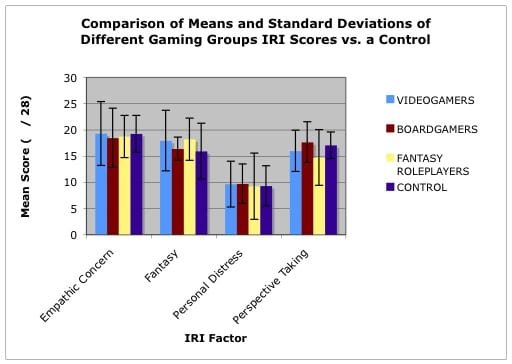Thinking Like An Opponent: The Relation Between Empathy, Competition, and Enjoyment in Gaming

James O. Butler, PhD
University of Glasgow
As personality traits may be considered stable aspects of individual difference, it is suggested that empathy might bear a relational role with those who participate in gaming pursuits. Three kinds of gaming hobbies – video-, fantasy roleplaying, and board- – will be assessed for the extent to which each might strengthen (or indeed be the result of a higher base level of) empathic ability. Qualitative results were unfortunately inconclusive; none of the groups exhibited a significant difference from the control, across any of the four empathic factors identified by Davis’ Interpersonal Reactivity Index (1980). Discussion points turn to reasons why gamers partake on their hobby, for which social interaction and passive enjoyment are key aspects, rather than competition and victory.
 James O. Butler, PhD, MBPsS, works in the area of psycholinguistics, terrapsychology, medical and digital humanities and clinical gaming studies. He is geodata Co-ordinator of the Cullen Project at The University of Glasgow. An avid gamer, you can connect with him at XBL Gamertag: Clockpunk; Steam: clockpvnk; PSN: Clockpunk or on Twitter @Clock_punk
James O. Butler, PhD, MBPsS, works in the area of psycholinguistics, terrapsychology, medical and digital humanities and clinical gaming studies. He is geodata Co-ordinator of the Cullen Project at The University of Glasgow. An avid gamer, you can connect with him at XBL Gamertag: Clockpunk; Steam: clockpvnk; PSN: Clockpunk or on Twitter @Clock_punk
Introduction
Gaming may be identified as a major – and constantly growing – part of interactive social relations that has regrettably seen only a minuscule amount of research addressing potential psychological ramifications. This research seeks to discuss the extent to which empathy may be a central component of participating in such social pursuits, and investigate whether those who identify themselves as being ‘core’ gamers (that is, ‘hardcore’, identifying the pursuit as holding a prominent position within their everyday life) might see a boon in this persistent personality trait and, if this is the case, whether this might be transferred outside of an isolated social context of gaming.
The potential benefits of ludology in its various forms has been recognised as being ripe for investigation with a wide interdisciplinary enmeshment that crosses many distinct fields of psychology. Gobet, Retschitzki, and de Voogt (2004, p. 6-7) make this claim, and although their research is firmly entrenched in investigating the cognitive, learning, expertise, and artificial intelligence-based uses of games as methodological equipment, this research will reverse their focus and examine whether gaming may itself be a tool of psychological influence.
The three distinct research questions that shall be posed and be addressed throughout this paper are:
1) Does gaming promote a higher capacity for the measured persistent personality trait of empathic ability, to any degree?
2) To what extent do competitive inclinations form the primary motivation for gaming?
3) What relationship, if any, may be identified between the level of interactive feedback of preferred gaming pursuit, and the extent to which empathy may differ between the groups.
It is expected that the three gaming populations will all show a higher level of empathy than the control, and these will be ranked on the ratings accordingly by the level of the social interactivity and alternative role-adoption required by the hobbies, namely: roleplaying, videogaming, then boardgaming. Each of these types of gaming require move planning, contextual knowledge of both environment (the playing field) and rules of engagement, and evaluation of the likely course(s) of action that an opponent may take – built from an amalgamation of external knowledge or experience, observed analysis of play-style, and assessment of individual behaviour within that singular environment. It is further predicted that competition will provide a primary impetus for participating in, deriving enjoyment from, and encourage empathic development by way of tactical confrontation, for each pursuits.
Throughout prior psychological research, van Leeuwen and Westwood (2008, p. 160) comment on the fact that ‘play is seldom studied in its meaning for the player but rather as a means to achieve developmental goals’, arguably exploring the latter is in many ways dependent upon the former. We learn through social engagement and experience, and it may be suggested that the personality aspect of empathy follows this same route of development; something that is strengthened by exposure to, and undertakings in, the emotional assessment of others, especially when motivated to do so by external factors (such as victory in competition).
The unifying hypothesis of the author is that the following patterns will be observable in both the quantitative data and qualitative reports: experience in strategic competition will be reflected in a higher level of empathic ability. This prediction is made in light of the fundamental need, identified as being at the core of gaming pursuits, that victory requires engaging with the decision making techniques – and by way of this, other cognitive processes including factors such as personality, emotional and contextual attributions – deemed available to an opponent.
This need for a high level of understanding the tactical inclinations of others during these interactive situations may form the basis of an enhanced level of empathy that may see transferal from the domain of the individual context to the wider personality of an individual.
Literature Review
Definition of Games and Gaming
 Although games, in a large variety of forms, are a fundamental part of human activity, it is important to outline the precise features of what construes ‘gaming’ and ‘gamers’ in the context of this study. As highlighted in the Introduction, three separate subgroups will provide comparative data, the specialist interests of which all share a great deal of overlap. Taking the Caillois structuralistic classification of different styles of play (1961, p. 41), each falls under his adoption of the term ‘agon’, which is characterized by ‘contests in which skill and chance are subtly blended’, where reading one’s opponent is an integral part of determining whether luck should be pushed or not.
Although games, in a large variety of forms, are a fundamental part of human activity, it is important to outline the precise features of what construes ‘gaming’ and ‘gamers’ in the context of this study. As highlighted in the Introduction, three separate subgroups will provide comparative data, the specialist interests of which all share a great deal of overlap. Taking the Caillois structuralistic classification of different styles of play (1961, p. 41), each falls under his adoption of the term ‘agon’, which is characterized by ‘contests in which skill and chance are subtly blended’, where reading one’s opponent is an integral part of determining whether luck should be pushed or not.
One of the key qualities ascribed to games, rather than the more general leisurely-based play, is provided by Juul (2003), who asserts that it is the concept of a player’s attachment to the outcome that serves as a core component of such pursuits, a sentiment shared by other research (c.f. Hearst, 1967; Yee, 2006; McGonigal, 2010; Ferguson & Olson, 2013), which suggests that it is the engagement that provides an important stimulus for the pursuit. However, there exists a range game types that differ greatly in the exact form of social interaction that underlies each pursuit, spanning single player versus a programmed AI, co-operative teamwork, and competitive multiplayer, each aspect spanning the three types of gaming herein examined.
A succinct definition of fantasy roleplaying games is offered by MacKay (2001, p. 4), who describes fantasy roleplaying games as: ‘[A]n episodic and participatory story-creation system that includes a set of quantified rules that assist a group of players and a gamemaster [sic] in determining how their fictional characters’ spontaneous interactions are resolved”, which contains all of the common elements seen in a myriad of alternative definitions (c.f. Fine, 1983; Schick, 1991; Brown, 2006; and Curran, 2011 for similar descriptions). Players adopt the role of an individual within the game world, and have complete freedom of action to interact with the setting as they may choose, working alongside (or against) other players as well as the population and situations devised by the player in control of the game world (the ‘Games Master’, or ‘GM’).
In a brief description of the benefits to participating in fantasy roleplaying, Schick argues that such games ‘expose realities and possibilities that might never occur to [a person] otherwise’ (1991, p. 14), requiring a flexibility of imagination and, consequentially, mind. The hypothesis that players these types of games might display a higher level of empathy compared to the other population sets is made on the basis of these definitions.
It is arguably the notion of change and reactionary response that lies at the heart of all forms of gaming. Every move, modifies the contextual situation, sometimes drastically – which lies at the heart of Gobet, Retschitzki, and de Voogt’s description of what may be termed ‘dynamic interpretation’ (2005, p. 133) – and the control of these changes, provides a core impetus for gaming. This builds upon the findings of Phelan & Richardson (1969) and Lanzetta & English (1989), both of which promote the importance of such situational management. Merilainen’s description of tactical adaptation where ‘the dynamic, interactive nature of the games [forces] the player to constantly reflect on both in-game and off-game happenings and adjust themselves in relation to the game world, the other characters and the other players’ (2012, p. 53), provides a concise summary of the common underlying mechanic of arguably all forms of gaming.
Definition of Empathy and its Social Role
The concept of ‘empathy’ is trickier to define, as it has a convoluted history of confounded definition and application across both scientific and artistic domain, sometimes treated as being synonymous with both emotional contagion, affective mimicry, and even as being primarily associated with sympathy – all three of which are related to the process, but do not serve as an adequate account of what it entails. The process is ultimately a sense of social awareness ‘through which a person shares an emotional experience with others either or both on an affective and cognitive level’ as argued by Wai and Tiliopolous (2012, p. 794), and it is this general understanding that forms the basis of most current psychological definitions (Murray, 1996; Engler, 1999; Keen, 2007). Kemp builds on this, stating that ‘one imaginatively places oneself in another’s situation in order to understand them’ (2012, p. 140), and it is this sense of the process that provides a potential link between empathy and opposition of all forms – it is only through understanding others that pertinent information with which to decide our own action may be acquired.
In regards to how empathy may be related to a broader understanding of individual personality, the Five Factor Model provides a suitable aspect that may be pertinent to exploring the relationship between gaming and empathy wherein the six facets listed as comprising the factor of Openness – fantasy, aesthetics, feelings, actions, ideas, and values (cited in Engler, 1999, p. 291) – all appear to be functionally relevant to the definitional scope of both empathy and gaming, providing a point of overlap where a relationship might be expected. Although this is dismissed outright by Curran, who argues that ‘in respect to personality, little or no evidence has been found to support a difference between role-playing gamers and the non-gaming population’ (2011, p. 54-55), she nevertheless suggests that individual traits might yield significant differences upon further specialised investigation.
Other traits have been proposed as alternative and appropriate understandings of competitive adaptation, including counter-empathy and Machiavellianism, with a succinct definition of the latter also broached by Wai and Tiliopolous as ‘provid[ing] an individual with sensitive emotional information, [and] may also underlie manipulative personalities’ (2012, p. 794), but neither of these capture the full degree of procedural involvement that may be presented as underlying competition. Rather, a tactical adoption of empathy may be required in order to leverage a greater understanding of the situational context (and through this, seek likely courses of action against which counter moves may be devised).
There is strong evidence that such impulses are indeed a personality trait. Deci and Olson have shown that ‘competition can both control behaviours and provide competence-relevant feedback’ (1989, p. 106), which in turn relates empathy to a wider motivational implication, highlighting just how involved the process may be in directing social assessment and interaction that forms a significant part of human operative capability that is not limited to just a role in altruism and pro-social behaviour. Although it has not been directly examined previously, the notion that empathy levels could bear some degree of correspondence with gameplay interaction has been broached by Lee, Guarjado, Short, and King, who suggest that:
‘fantasy play might support one’s understanding of others’ mental states…. Given the correlational nature of the research, the reverse is also possible; children who have a better understanding of others’ perspectives may be more inclined to experience the thoughts and feelings of characters’ (2010, p. 70).
This research is therefore built upon several recommendations made over the years in related works that have identified a number of areas that have regrettably been overlooked. The severest critics of games, as seen in Anderson et al. (2010), have only incorporated empathy into their study as relating to desensitization, which they measure physiologically rather than emotionally, and does not consequentially provide an adequate understanding of the cognitive complexities of the process. Hartmann, Toz and Brandon (2010) have shown that emotional responses do occur from in-game actions, which corresponds with Kemp’s arguments that imaginative responses ‘are to some extent the actual experience of what fictional characters do’ (2012, p. 142 – emphasis as originally appeared). It has been suggested that perhaps ‘imagining the inner world of others develops one’s empathic accuracy ability through sustained and motivated practice’ (Lee et al., 2010 70), and it is this possibility that provides a theoretical impetus.
Methodology
The experiment was conducted with a total of 80 participants divided evenly amongst four separate groups (the three gaming classifications and a control), exactly half of which were taken from a variety of subjects, academic backgrounds, and qualification level within the University of Glasgow. The dedicated student organisations Glasgow University Gaming Society (GUGS) and Glasgow University Network Gaming Society (GUNS) were solicited for participants, but in order to incorporate a wider array of subjects, the community forums of three specialist websites devoted to each of the gaming categories were also approached. These were VideoGamer.com, BoardGameGeek, and RPG.Net.
All of the subjects identified themselves as belonging primarily to the social group to which they were assigned, and believed that their gaming interest was a defining part of their personality and the hobby was a major part of their lives. There was no discrimination in the selection policy, with participants of any age, social, and cultural background taken.
The control group was comprised of non-gaming friends or relatives of participants, in addition to postgraduate-level and staff members from various disciplines within the University of Glasgow, and saw a similar level of variance with regards to age, sex, cultural, and social origin.
Design
Participants were tasked with completing two components of a questionnaire for this investigation. The first part provided the quantitative aspect of the investigation, and was comprised of the final design of the Interpersonal Reactivity Index (hereafter: IRI, see Appendix 2) designed by Davis (1980), which was designed to measure four separate aspects of empathy: Fantasy, Perspective Taking, Empathic Concern, and Personal Distress. This instrument is comprised of 28 items divided equally amongst the four areas, each graded on a 5-point Likert scale, which was modified from the original design only in the replacement of attributional values (from 0-4) with corresponding letters instead (A-E) for which a descriptive scale was provided. This change was made in order to circumvent any potential bias that might occur through the appearance of low values on a numerical scale, and this superficial masking change was agreed upon by both investigator and supervisor, and was noted in the ethical application.
Participants were asked to rate how well a given phrase described them, and two original entries were devised and provided, along with an explanation of what the given answer represented through interpretation. Participants were instructed to answer all of the items, and the digital survey was designed so as to allow only one option to be selected for each item at any time.
The IRI was chosen over alternative empathy measurement tools, such as the Hogan Empathy Scale, the Empathy Quotient Scale, and the Empathy Assessment Index, as the four isolated factors provided a working definition that suggest each of them may prove advantageous in the competitive context of gaming, as detailed in the Literature Review. The factor of ‘Fantasy’ is especially pertinent and was a major influence in deciding the appropriate tool, for it is designed to measure ‘the tendency to imaginatively transpose oneself into fictional situations’, and it is this feature that may prove to be the most important aspect of empathic ability for gamers as this encapsulates a central feature of the three hobby pursuits.
Previous research directly comparing personality scores between roleplayers and non-gamers has utilised the IRI (Dousen and MacManus, 1993), and the validity of the index has been identified as consistent, accurate, and valid across a range of personality- and professional-based assessment criteria (see: Yarnold, Bryant, Nightingale and Martin, 1996; Lee, Guarjado, Short, and King, 2010; Delpechitre, 2013). The continued use of the IRI, along with the precedent for assessing gaming populations, is indicative of its suitability for use in this research.
The second part comprised of six uniquely developed questions to be answered freely, and provided data for an additional qualitative assessment intended to compliment the quantitative results collected. They were designed so as to be interchangeable across all three gaming groups, and were not distributed to the control group, as they were intended to elicit discursive points of specific experiences whereby empathy may have been encountered within their chosen pursuit. In order to relate the key queries raised in the Literature Review with the hypotheses made within the Introduction, the six questions asked within the survey were based around three key thematic aspects:
- Preferred level of interaction (such as rules-heavy ‘crunch’ working within restricted parameters at all times, or rules-light ‘fluff’ with an emphasis on story-telling and experience (both colloquial terms, but frequently used across the three respective hobbies universally), which may provide evidence for tactical involvement.
- The level of involvement that the pursuit has in the life of the participant.
- What aspect of gaming provides the individual participant satisfaction, and therefore act as motivating factors to undertaking the pursuit (e.g. extrinsic competition, intrinsic puzzle-solving, etc).
Procedure and Stimuli
After participants had been recruited, they provided a contact e-mail address to which two forms were sent in .doc format, a copy of the consent form, and the two-part questionnaire. Both of these documents had been secured and password protected so that only the check boxes and designated answer areas could be edited. This allowed participants to provide a contact address so they could be sent the files digitally, and they could then complete the allotted task(s) at their convenience, in private, and in conditions that were comfortable to them. No incentive, financial or otherwise, was offered for participation, and the author was acquainted with several of the participants outside of the remit of the investigation and data collection.
Results
The collected surveys were converted to a numerical scale and graded manually by the author alone, which yielded the following data:
| Empathic Concern | Fantasy | Personal Distress | Perspective Taking | |||||
| Mean | St. Dev | Mean | St. Dev. | Mean | St. Dev. | Mean | St. Dev. | |
| Control | 19.267 | 3.494 | 15.933 | 5.311 | 9.333 | 3.830 | 17.067 | 2.549 |
| Video Gamers | 19.333 | 6.091 | 17.933 | 5.775 | 9.667 | 4.353 | 16.000 | 3.928 |
| Board Gamers | 18.467 | 5.655 | 16.400 | 2.197 | 9.733 | 3.770 | 17.667 | 3.885 |
| Fantasy Roleplaying Gamers | 18.733 | 4.044 | 18.200 | 4.021 | 9.267 | 6.319 | 14.733 | 5.298 |
There were no outliers, and so the data provided by all of the participants was included. This information is represented visually on the chart below, which clearly shows the extent to which the values overlap. It may also be seen that no consistent pattern emerges that may be used to rank the groups across the four factors.
A two-tailed independent means t-test assuming equal variances against the control group was run for each of the four factors in the three experimental groups, from which the following results were generated:
| VIDEO GAMERS | ||
| Empathic Concern | t(28) = 0.0368 | p = 0.970 |
| Fantasy | t(28) = 0.9872 | p = 0.331 |
| Personal Distress | t(28) = 0.2227 | p = 0.825 |
| Perspective Taking | t(28) = -0.8823 | p = 0.385 |
| BOARD GAMERS | ||
| Empathic Concern | t(28) = -0.4661 | p = 0.645 |
| Fantasy | t(28) = 0.3144 | p = 0.756 |
| Personal Distress | t(28) = 0.2883 | p = 0.775 |
| Perspective Taking | t(28) = 0.5001 | p = 0.621 |
| FANTASY ROLEPLAYING GAMERS | ||
| Empathic Concern | t(28) = -0.3865 | p = 0.702 |
| Fantasy | t(28) = 1.3178 | p = 0.198 |
| Personal Distress | t(28) = -0.0349 | p = 0.972 |
| Perspective Taking | t(28) = -1.5372 | p = 0.135 |
There is consequentially no statistically significant difference between any of the three gaming populations and the non-gaming control, across any of the four empathic factors measured, thereby confirming the null hypothesis, which must be accepted for two of the predictions made at the outset of this report.
There is no persistent difference in personality (research question 1), nor does the level of interaction appear to bear any relation with empathic ability/preference, given the varied means and high standard deviations seen for each of the factors (research question 3). The second question cannot be answered by examining this qualitative data, which may be taken as a preliminary indication of the artificiality in separating the direct report and supporting discussion of this type of data.
The non-specific population data provided by Davis (1980) with the initial release of the IRI was not used in capacity, due to the significant time lapse, coupled with the participatory size and almost equal ratio between genders (totaling 1161, comprised of 579 males and 582 females) from an American population, not allowing for a directly comparable social divide.
Discussion
Quantitative Data
The primary hypotheses made at the outset of this investigation, in light of the three research questions posed, predicted that there would be observable increases in the empathy levels of gamers when compared to non-gamers, and that this relationship might be more strongly in competitive contexts and level of interactivity, which would translate to a ranking in the following group order fantasy roleplaying, videogaming, boardgaming, then the control. The quantitative data does not support either of these, and therefore the null hypothesis – that the empathic aspect of personality shows no significant difference between gamers and non-gamers – must be accepted. This follows the findings of prior work that investigated personality on a broader non-specific scale (e.g. Curran, 2011). There is no observable consistency in regards to the group rankings of the four separate factors by mean, indicating that no form of gaming promotes (or hinders) any aspect of empathic development, as defined and structurally delineated by the IRI tool.
Similarly, the large standard deviations show the extent to which the data collected was due to expected individual variation, and that there was no preferential dispositions for (or manipulation by) the gaming pursuit enjoyed. No group displayed an inarguable distinction in any one empathic area. This evidence does not support the hypotheses made in the commencement of this research, suggesting that individuals of all personality types enjoy these leisure pursuits, with no underlying personality-based differences either resulting from or spurring developmental processes beyond a desire for entertainment. This does, however, raise doubts about the validity of arguments provided by Anderson et. al. (2010) that videogames encourage and elicit aggression and hostile personality traits, any more than any other hobby that is comprised of competition might, which shall be looked at in greater detail within the following qualitative analysis.
The evidence provided by the data collected conclusively shows that there is no discrete difference in the empathy levels of gamers that has any bearing from or on their chosen hobby, and that differences in the four subfactors are due to standard individual differences. This disagrees with Douse and MacManus’ conclusion that ‘to some extent individuals who are interested in any hobby or interest will differ from the population average,’ in highly specialised personality factors, and despite the social difference in gaming type that formed their investigation (‘Play by Mail games’ that did not require direct personal interaction), these measured empathy levels also ‘fit within that perspective’ (1993, p. 508).
Qualitative Feedback
Answers provided to the additional survey appended to the IRI revealed several consistent patterns as to how and for what reasons participants engaged in their chosen pursuit, as well as the rewards they enjoyed. While the quantitative data strongly indicated there was no evidence for any difference in empathy, either with gamers as a population unto itself or separate subgroups formed around different levels of interactivity, the discursive feedback did provide anecdotal evidence as to the extent with which competition acted as a readily apparent motivation.
The most consistent element regarding motivation observable across all three groups was the identification of gaming as a platform for the sharing an experience providing the main form of enjoyment, be it working together in-game, or serving as an opportunity to engage with others socially outside of the game. Reference to the hobbies serving as a locus for social events featured in the majority of responses, both for families: ‘the greatest pleasure is anytime I can play games with my wife & daughters’ (RPG15), and friends: ‘without a doubt: hanging out with friends even when we are far apart, and sharing an experience. Many happy memories formed through gaming’ (VG18). This factor was regarded above actual victory in a game, much less competition, with two respondents stating that they gamed ‘just to have fun and enjoy each other’s company. I care very little about the outcome’ (BG5), and ‘hanging out online – we’re old friends, but scattered across the country – the online environment doesn’t care for boundaries, and just goofing around is the most relaxing and rewarding pastime I can imagine’ (VG7).
One participant highlighted that they believed gaming to offer a means of social interaction that could not be attained by other means, with the pursuits providing ‘a unique experience which is hard to recreate other ways’ (BG4). It is possible that this might be an opinion shared by those who engage in any other hobby and seek to form friendships in a similar network, but the interactivity of the pursuit was alluded to as the basis for forming novel experiences that could not otherwise be experienced: ‘I like to see how they react to various situations and how they process the data given them’ (RPG1). The exploration of novel situations and puzzles, and the ensuing reactions and thought-processes, here form the basis for mutual enjoyment.
There was, however, hints of competition in the answers, with two members of the boardgaming group identifying it as a factor guiding their enjoyment: ‘In order, 1) thinking hard, 2) competing, and 3) having fun with my friends and family’ (BG1), yet even here it is still not the primary aspect. It was the videogaming group that provided a number of responses naming competition as forming an intrinsic part of their motivation: ‘when in multiplayer, very competitive, love to win’ (VG3). However, these responses were a minority, and were even qualified in two ways, both of which were tightly integrated into the level of enjoyment gleaned from a title, either providing a quintessential purpose, (in response to playing style): ‘Balls to the wall. I just have fun, as that is the main aim to achieve. I am competitive, as that is what makes for a great session, what makes it all fun’ (VG1), or providing ancillary reward: ‘Ranking high definitely provides a nice little ego boost – I’m not a rage quitter, but I can see why some do – but it is still bad sportsmanship’ (VG19). It is interesting that gaming is equated to a sport, which may be representative of the skill that is required in this type of gaming more than both boardgaming or fantasy roleplaying, which feature increasing degrees of luck in their gameplay form and provision of victory opportunities. This fits the claims of Dovey and Kennedy (2006) previously examined, concerning emotional responses of victory – in this case, enjoyment – not being dependent upon personal competence, which may account for its low status in these subjective self-assessments.
Answers regarding the amount of time spent engaging with their chosen form of gaming in some form were also solicited, for the results were again fairly consistent, with a high level of interaction that in almost all cases was reported as a daily occurrence. Actual playing was much more frequent with the videogaming group, which may be attributable to the fact that such games can be easily played solo and remotely, can require very little time, and otherwise requires a minimal amount of social organisation. Two answers typical of those provided are: ‘I’d estimate 80% of my waking hours involve playing, thinking, reading, writing etc. about gaming’ (VG3) and ‘Gaming is a huge part of my life! I go on gaming websites every day, game several nights a week and am even going to [annual previews convention] Gamescom!’ (VG5). The fantasy roleplaying market is not as active, and even though actual play occurred far less often (commonly reported to be once a week or month), a similar level of indirect participation in the hobby through daily was observed across the group: ‘any down time from work or night classes is usually spent reading/writing or thinking about a game’ (RPG11). The modular and subjective nature of such games allows for a greater freedom in interpretation than either of the other two gaming types, which might correspond to a greater level of participation through discourse and discussion: ‘It’s my primary social activity. I spend 2-3 hours per day on gaming websites, and often run two 4-6 hour games per’ (RPG3). However, because a number of participants were recruited from dedicated online discussion boards, this could potentially have introduced a level of skewed bias in this regard.
The boardgaming hobby shares a similar level of niche market awareness, which resulted in responses that revealed an equivalent high level of maintained engagement with the pursuit outside of actual play, with participants also reporting a routine of daily engagement: ‘although I see actual play far less frequently than I would like, I still check out news and informational sites pretty much every day, normally around an hour or so, per’ (BG16), which was echoed throughout the group. Even just spending time appreciating one’s collection was reported to provide satisfaction: ‘at least an hour or two per day just reading news, familiarizing myself with rules, just enjoying my collection, and checking out upcoming releases’ (BG5), suggesting that the pleasure from all three pursuits is not derived solely from direct play, further connecting both social and physical accumulation factors – which are again not unique to gaming as a hobby.
Despite the lack of quantitative evidence for a relationship with empathic development, a consistent pattern of positive regard for personality strengths perceived as resulting from their chosen hobby was again observed across all three groups, most noticeably in the field of decision making. Several respondents emphatically stated this to be the case: ‘Gaming has also most definitely influenced how I think, such as decision making skills and my responsiveness/ingenuity’ (VG7) and that gaming provided ‘the forces that molded me into the person I am. I believe I think “outside the box” more than any of my work colleagues, which has led to benefits on many an occasion,’(RPG5). Similarly, the solving of puzzles and the attempting of different courses of action also provided interest: ‘I like games where we both hatch plans, and see whose plan comes out the best – this has certainly carried over into real world application, seeing possibilities others don’t’ (BG2), which correesponds with the situational task enjoyment noted earlier.
This perceived higher level of creative thought might be attributable to the frequent engagement with these pursuits that require a level of personal detatchment so as to consider situations from a third-person perspective; a situation by which gamers necessarily experience their hobbies. This identification follows the suggestion of Merilainen, that ‘regardless of age or gender, the majority of respondents reported that role-playing games were an important or somewhat important part of their personality’ (2012, p. 56), which is another idea that spans any hobby or leisure pursuit, not just gaming.
Reflexive Analysis
The author feels that his active involvement in all three hobbies should be noted. He has had numerous works for roleplaying games published spanning a decade of writing, both professionally and through amateur resources; serves as a playtester for several boardgame publishing companies, and has been an ardent player of video games for over 23 years, playing almost daily, at the time of writing. However, given the null hypothesis and efforts to ensure there was no part of the questionnaire that could be construed as leading participants towards providing a desired response, the author believes that the report is objective in its findings and analysis.
Conclusions
Although the hypotheses of this report were not met by the quantitative data gathered, and fell in line with other research in suggested there is no difference between gamers and non-gamers through measurable personality traits, the qualitative data draws attention to one particular avenue that might form the basis of future work. Further investigation into the extent to which behaviour might be modified so as to facilitate and maintain leisure play, be the pursuit actively or passively engaged. This is arguably no different to any other hobby, but such work might be useful to counter another stigmatic argument that is currently taking hold in popular media, of the idea of what some term ‘addiction’ – obsession with engaging in such pursuits, to the detrimental exclusion of other social aspects of life – as if gamers are particularly vulnerable to the development of such tendencies.
Gaming is becoming more of a mainstream activity than it was during the period in which many of the previous investigations were undertaken, especially videogames, and so the arguments made by Crawford (2012, p. 64-65) that the term ‘gamer’ might now be seen as a little too ambiguous and broad, might render such distinctions moot. The author did endeavour to account for this potential factor by approaching those only with an active interest in their gaming hobby rather than a casual inclination, but as this is an entirely subjective value, the same criticisms of potential biases that may be leveled against any form of self-report measures may also be applicable to social assessment of both the self and others.
The qualitative data gathered suggests that passive participation represents a major component of gaming hobbies, which corresponds nicely with the suggestion made by van Leeuwen and Westwood that ‘play is not just an activity but a state of mind’ (2008, p. 154). Such a persistent aspect should have some identifiable bearing on personality, but not – as has been shown – anything directly concerning empathy.
Bibliography
Anderson, Craig A.; Shibuya, Akiko; Ihori, Nobuko; Swing, Edward L.; Bushman, Brad J.; Sakamoto, Akira; Rothstein, Hannah R. and Saleem, Muniba (2010). Violent video game effects on aggression, empathy, and prosocial behavior in Eastern and Western countries, Psychological Bulletin 136, 151–173.
Brown, Harry J. (2008) Videogames and Education. London: M.E.Sharpe.
Caillois, Roger (1961) Man Play and Games [transl. Barash, Meyer]. Chicago, Illinois: University of Illinios Press.
Carroll, James L. and Carolin, Paul M. (1989) Relationship between Game Playing and Personality, Psychological Reports 64, 705-706.
Crawford, Garry (2012) Video Gamers. Abingdon: Routledge.
Curran, Noirin (2011) Stereotype and Individual Differences in Role-Playing Games, The International Journal of Role-Playing 2, 44-58.
Davis, Mark H. (1980) A Multidimensional Approach to Individual Differences in Empathy. JSAS Catalog of Selected Documents in Psychology 10, 85-104.
Deci, Edward L. and Olson, Bradley C. (1989) Motivation and Competition: Their Roles in Sports, in: [ed.] Goldstein, Jeffrey H. (1989) Sports, games, and Play: Social and Psychological Viewpoints, 83-110. Hillsdale, New Jersey: Lawrence Erlbaum Associates, Inc.
Delpechitre, Duleep (2013) Review and assessment of past empathy scales to measure salesperson’s empathy, Journal of Management and Marketing Research 13, <http://www.aabri.com/manuscripts/121429.pdf>; [last accessed: 26/06/13].
Dousen, Neil A. and McManus. I. C. (1993) The personality of fantasy game players, British Journal of Psychology 84, 505-509.
Engler, Barbara (1999) Personality Theories: An Introduction, 5th Edition. Boston; New York: Houghton MifflinCompany.
Ferguson, Christopher J., & Olson, Cheryl K. (2013) Friends, fun, frustration and fantasy: Child motivations for video game play, Motivation and Emotion 37, 154-164.
Fine, Gary A. (1983) Shared Fantasy: Role-Playing Games as Social Worlds. Chicago: University of Chicago Press.
Gobet, Fernand; Retschitzki, Jean; and de Voogt, Alex (2004) Moves In Mind: The Psychology of Board Games. New York: Psychology Press.
Hartmann, Tilo; Toz, Erhan and Brandon, Marvin (2010) Just a Game? Unjustified Virtual Violence Produces Guilt in Empathetic Players, Media Psychology 13, 339-363.
Hearst Elliot S. (1967) Psychology Across the Chessboard. Psychology Today 1, 29-37.
Juul, Jesper (2003) The Game, The Player, The World: Looking for a Heart of Gameness, in: [eds.] Copier, Marinka and Raessens, Joost (2003) Level Up: Digital Games Research Conference Proceedings, 30-47. Utrecht: University of Utrecht Press; < http://www.jesperjuul.net/text/gameplayerworld/>; [last accessed: 26/06/13].
Keen, Suzanne (2007) Empathy and the Novel. Oxford: Oxford University Press.
Kemp, Rich (2012) Embodied Acting: What neuroscience tells us about performance. Abingdon: Routledge.
Lanzetta, John T. and Englis, Basil G. (1989) Expectations of Cooperation and Competition and Their Effects on Observers’ Vicarious Emotional Responses, Journal of Personality and Social Psychology 56, 543-554.
Lee, Sherman A.; Guarjado, Nicole R.; Short, Stephen D. and King, William (2010) Individual differences in ocular level empathic accuracy ability: The predictive power of fantasy empathy, Personality and Individual Differences 49, 68-71.
van Leeuwen, Lieselotte and Westwood, Diane (2008) Adult Play, Psychology and Design, Digital Creativity 19, 153-161.
Mackay, Daniel (2001) The Fantasy Role-Playing Game: A New Performing Art. Jefferson, North Carolina: McFarland.
McGonigal, Jane (2011) Reality is Broken: Why Games Make Us Better and How They Can Change the World. London: Jonathon Cape.
Meriläinen, Mikko (2012) The self-perceived effects of the role-playing hobby on personal development – a survey report, The International Journal of Role-Playing 3, 49-68.
Murray, Peter B. (1996) Shakespeare’s Imagined Persons: The Psychology of Role-Playing and Acting. Basingstoke: Macmillan Press Ltd.
Phelan, Joseph G. and Richardson, Edward (1969) Cognitive Complexity, Strategy of the Other Player, and Two-Person Game Behavior, The Journal of Psychology: Interdisciplinary and Applied 71, 205-215.
Schick, Lawrence (1991) Heroic Worlds: A History and Guide to Role-Playing Games. New York, New York: Prometheus Books.
Smith, Murray (2011) Empathy, Expansionism, and the Extended Mind, in: [eds.] Coplan, Amy and Goldie, Peter (2011) Empathy: Philosophical and Psychological Perspectives, 101-117. Oxford: Oxford University Press.
Wai, Michael and Tiliopolous, Niko (2012) The affective and cognitive empathic nature of the dark triad of personality, Personality and Individual Differences 52, 794-799.
Yarnold, Paul R., Bryant, F. B., Nightingale, S. D. and Martin, G. J. (1996) Assessing physician empathy using the Interpersonal Reactivity Index: a measurement model and cross sectional analysis, Psychology, Health & Medicine 1, 207-221.
Yee, N. (2006). Motivations for play in online games. CyberPsychology and Behavior, 9, 772–775. doi: 10.1089/cpb.2006.9.772






